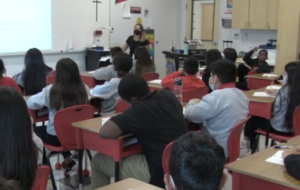09.07.22How Brittany Carson Starts the Year with Show Call

Up here at TLAC Towers, Show Call is one of our very favorite techniques.
Think of it as a visual Cold Call with a whole lot of additional benefits.
In a Show Call you present a piece of student work, chosen at your discretion and regardless of who volunteers, to look at and study as a class.
It’s a great way to study common mistakes and make students feel like they are both normal and valuable.
And it’s a great way to revise and improve written work.
You can see Brittany Carson, a 6th grade science teacher at Memphis Rise Academy doing that–and crushing it!–here:
Not only is Brittany’s Show Call really good but it’s a really effective model of how you might use Show Call early in the school year when you are building students’ familiarity and comfort with the technique.
For example, while you don’t have to make Show Calls anonymous–most of the time we don’t actually–it’s nice to do the first few times you try it just to diffuse any potential anxiety.
Here Brittany does that nicely. Her “take” is super subtle (you can’t tell whose work it is) and she says: “We’re going to look at someone’s work and talk about it a little bit” as if that’s the most natural thing in the world. (We kind of think it should be). But also keeping the author anonymous. It helps that her tone is easy-going and upbeat.
Meanwhile there’s now a system of accountability in place for written work. Message: “What you write might get shared. That’s a good thing. But always do your best work on writing tasks just in case.”
That’s powerful, simple and important.
Showing work you want to edit or have students study is very important! In fact we’d say anytime you want to study student work it should ALWAYS be visible.
That’s because the transient information effect tells us that if we are talking about student work that we are not also looking at, students’ Working Memory will be overloaded and they will not get as much as they could out of the exercise as they could.
For example if Brittany had merely read the student’s answer and asked classmates to suggest improvements, students would have to both remember the original sentence and analyze it and try to remember why and how they’d improved it, all at the same time. This would put an immense load on working memory. (Trying to hold the original sentence in WM would essentially use most of it). They would struggle to do any of those tasks well and would forget most of it. But with the work visible, students don’t have to use WM remembering. They can just study it.
Showing the student’s work, Brittany complements it. It’s good work and she calls out some of its strengths. And then she adds: “What could we add on to this sentence to make it even better?”
What a great phrase: “even better”.. it captures the idea that we are always trying to improve even when we’ve done good work. It reminds students that good work is just the beginning.
Notice though that in addition to studying their classmates’ work and learning form it, Brittany is constantly directing students’ attention back to their own papers, causing them to build a habit of comparing what they see to their own work. For example she says: “If you wrote something like higher or height go ahead and underline that on your paper. Give yourself a check mark.” “If you wrote the word ‘store’ give yourself a check mark.”
Also, as Brittany asks for suggestions she always models how to include them on the sample on the board. They are always applying the feedback. And notice that the students understand that the changes she makes should be mirrored by edits they make to their own paper. But Brittany also reinforces this nicely: “Circle where you wrote the word more. If you didn’t, add it in like i just did to this sentence.”
Notice also how she makes it clear she’s watching to see if they do that: “Thank you, Vanessa. Thank you, Christopher,” is a lovely and appreciative way of saying: “When I ask you to complete a task I will watch to see whether you do it.” This builds a culture of follow-through.
Now students have a model answer in their notes to refer to!
And Brittany’s class is off and running!
